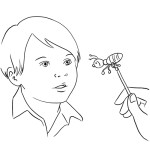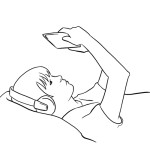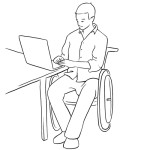Use distraction!
Distraction is one of the BEST ways that you can help your child cope with necessary care at home. Depending on your child’s developmental stage and personality, some techniques will work better than others. Find that strategies that suit your child best. If you are struggling to find an effective distraction technique at home, please discuss with your health care team; they will be able to help you “fine-tune” these recommendations.
What is distraction?
Distraction is a method (behavior modification) that helps a child (or adult!) focus attention on a preferred activity in order to think less about another, less desirable (but necessary…) activity. Distraction helps children be less anxious and more relaxed. It works well in most children, using their natural curiosity to be interested in a pleasant activity. It is especially helpful for children with chronic conditions who need to have repeated treatments. Over time, distraction teaches your child how to self-calm; this is a valuable coping skill.
How does distraction help?
Essentially, distraction helps a child feel more relaxed and better able to handle receiving care, even when that care is a bit uncomfortable or painful. Distraction can:
Reduce fear and anxiety
Empower your child (and you!)
Decrease pain awareness
Make the next treatment much easier…
Golden rules for making distraction work!
- Timing is key: always begin the distraction BEFORE the care; position your child for comfort first, then start distraction
- Distraction requires focus: yours and your child’s. Have at least two tools for distraction ready to use and be prepared to refocus your child’s attention on the tool throughout the procedure. You may need the help of another adult so that the care can be completed safely.
- Pay attention and acknowledge your child’s emotions, like distress, and then refocus your child’s attention on the distraction.
- Experiment with different methods of distraction (see the table below for some suggestions). You may need to try different methods before you find the ones that fit your child best. As children grow and develop, their needs change and you will need to adjust the distraction method accordingly.
Look at the table below for ideas to get you started. Follow the lead of your child and use the techniques (combinations work well!) that fit your child best. A lightweight tablet or cellphone, with videos, games and family photos can be a useful, and portable tool for distraction in all age groups.
| Comfort and distraction strategies for all children | |||||
| Developmental stage/age | Infants |
Toddlers |
Preschoolers |
School-aged children |
Adolescents |
| Comfort and stress management | Stay close by, your physical presence is comforting
Allow your infant to play before the care to decrease anxiety Minimize unnecessary noise Ensure a calm and relaxed ambiance Play familiar, preferred music (establish a routine) Consider using a comfort object, like a stuffed toy, blanket or pacifier to soothe your child |
Stay close by, your physical presence is comforting
Use medical play to demonstrate and explain simply what will be done, predictability is soothing to young children and gives them a sense of security Establish a routine for the care and encourage autonomy by allowing your toddler to choose a comfort object, like a stuffed toy or blanket Consider using music or a favourite song as part of the routine of care Start to teach your child simple tasks to participate in the care, for example, holding an alcohol swab |
Stay close by, your physical presence is comforting
Use medical play to prepare the child. Allow the child to explore medical supplies Explain simply the care that is required Encourage autonomy by offering realistic choices; eg, type of distraction or location of care Encourage your child to help create the routine of care Promote collaboration by teaching your child how to participate in aspects of the care |
Let your child decide if they wish for you to stay close by, encourage and recognize gradual independence
Use medical play Offer other expressive play opportunities: drawing and art; superheroes and symbolic games, these facilitate emotional expression Empower the child by encouraging autonomy and offering realistic choices Encourage your child to share in the responsibility for care by delegating specific tasks, with supervision |
Let your adolescent decide if they wish for you to stay close by, encourage and recognize gradual independence
Encourage participation in decision-making and medical care Offer honest and factual explanations, remain attentive to your adolescent’s verbal and behavioural cues Encourage your adolescent to prepare for the care as much as is reasonable, aiming for progressive autonomy Consider a positive peer role model, if your adolescent is interested in this |
| Massage
Gentle stroking of the head, arms, legs, back can be very soothing to a young child |
Massage
Gentle stroking of the head, arms, legs, back can be very soothing to a young child |
Guided imagery | Guided imagery
Yoga/meditation |
Guided imagery
Yoga/meditation |
|
| Position your infant for comfort | Position your toddler for comfort, use a sitting position if possible to encourage autonomy | Let your child choose their preferred position for care | Let your child choose their preferred position for care | Let your adolescent choose their preferred position for care | |
| Distraction | Speak to your child in a calm, confident and soothing voice
Sing to/with your child Watch a movie, cartoon, video; look at family photos Blow bubbles Toys with lights, sounds, movement Puppets Interactive games like Peek-a-boo |
Speak to your child in a calm, confident and soothing voice
Give simple instructions to your child as needed and praise your child’s efforts Sing to/with your child Watch a movie, television show, video, look at family photos Blow bubbles Toys with lights, sounds, movement Puppets Interactive games like Peek-a-boo Drawing, simple crafts |
Set clear expectations and limits
Give instructions to your child as needed and praise your child’s efforts Watch a movie, television show, video Puppets Drawing, simple crafts Play simple board games or computer games |
Encourage, recognize and praise cooperation and self-control
Read a book (together or on his/her own) Watch a movie, television show, video Computer or phone games Play board games, or electronic version (Connect 4, Snakes and ladders, card games) Drawing, crafts |
Encourage, recognize and praise cooperation and self-control
Read a book Writing something; eg, a story or poem Watch a movie, television show, video Computer or phone games Play board games, or electronic version (chess, checkers, puzzles, etc) Drawing, crafts |
| Have on hand several different tools (toys) for distraction so that you can refocus your child’s attention on the distraction as needed | Have on hand several different tools (toys) for distraction so that you can refocus your child’s attention on the distraction as needed | Engage your child in a conversation on a preferred topic (what they will do after the treatment, recounting a funny story, planning an event, like going to the park, etc)
Use humour, jokes Mystery books (where’s waldo, hidden objects, mystery novels, etc) |
Engage your child in a conversation on a preferred topic (what they will do after the treatment, recounting a funny story, planning an event, like going to the park, etc)
Use humour, jokes Mystery books (where’s waldo, hidden objects, mystery novels, etc) |
Encourage increasing autonomy with the required medical care; providing reassurance and supervision as required | |
Special distraction/comfort techniques:
Guided imagery
This is a powerful technique where children use their imaginations to have a sensory experience (imagining scenes, smells, textures, actions, etc) that helps them to relax and be distracted from some less pleasant activity (like having a medical procedure!). Basically, a child is guided through a pleasant experience (visiting a favourite place, having a fairy-tale adventure, doing a preferred activity, etc) and creates mental images of this positive experience. The child’s body responds to these positive images, by feeling more relaxed and comfortable. This also works in adults, but children have the advantage with their natural senses of curiosity and imagination!
If you are interested in trying this with your child, speak to your health care team. Many child psychologists, child life workers and nurses have experience with this technique and can help you and your child learn how to use it.
Controlled breathing
You may already know that slow and deep breathing helps a person relax – and this certainly works in children too! This technique can be easily taught to many children and will help them feel more calm, more in control of the situation. Here’s how it works:
Take a slow and deep inhale breath through the nose
Slowly exhale through the mouth or nose, whichever is more comfortable
Breath in a smooth, regular pattern
Stop if you feel faint!
Practice to get better at this…
This technique is easy to role-model and to teach to school aged children and adolescents (it also helps adults!). In younger children, try using these tips to help with the deep breathing:
Use a whistle or a toy flute
Blow bubbles with your child
Blow on a toy pinwheel
Help your child imagine that he/she is blowing out birthday candles








